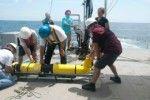Though 70 percent of the earth’s surface is covered by oceans, 95 percent of these waters are currently unexplored, according to the National Oceanic and Atmospheric Administration. Researchers at Texas A&M are working to discover more about these murky depths with new unmanned, missile-shaped Slocum gliders.
The new gliders were developed by a team of scientists and technicians from the Geochemical and Environmental Research Group in both the Department of Oceanography at Texas A&M and Texas A&M Galveston. The gliders carry a multitude of sensors to measure salinity, temperature, dissolved oxygen and currents.
“They are remote instruments instead of just ships that let us go out and research,” said Anthony Knap, director of the research group. “While other research gathering devices, such as those on ships, simply float on the ocean, these go under the water and can even stay out during dreadful weather and can keep doing their job. These remote systems are really going to take over.”
Steve DiMarco, oceanographer and lead scientist on the project, said the glider’s ability to research underwater for extended periods provided advantages beyond current technology.
“Its capabilities allow us to sample below the surface on a regional scale – something we have never been able to do,” he said in a statement.
Zhankun Wang, assistant research scientist in oceanography involved with the testing of the gliders, said the gliders were the future of oceanography.
“This data can be very useful to study the Gulf of Mexico,” Wang said. “This is the first scientific deployment and I’m sure that in the future we will add more sensors to make it more powerful and collect more data. The glider is a new technology compared to the traditional methods. I think this is the future of ocean observation and that more and more research will be autonomously collected data.”
Ruth Mullins, a postdoctoral research associate in oceanography and glider pilot, said she was one of the pilots for the first successful deployment of the gliders in August. The gliders were released 40 miles southeast of Galveston.
Heather Zimmerle, a graduate research assistant in oceanography working on the project, said the initial research in the Gulf of Mexico will be important, but the gliders can be used across the world.
“Right now, deploying the gliders in the Gulf of Mexico will allow us to monitor various known hazards in the region, such as oil spills and hypoxia,” Zimmerle said. “Because the gliders are so versatile, researchers at Texas A&M will be able to use the gliders in other areas in the world.”
Mullins said the glider can be altered for optimal use by scientists depending on their research and region.
“Scientists have a tremendous flexibility in the scientific design of a glider, meaning that scientists can add any number of specialized sensors to measure different parameters in the ocean – from temperature and salinity, to dissolved oxygen, to adding hydrophones to listen for marine mammals. The scientific versatility of gliders will help scientists discover new features of the ocean and to improve upon environmental monitoring.”
Mullins said the gliders will bring Texas A&M and the field of oceanography into the 21st century and benefit students and the community.
“Having an operational glider center will further improve students’ working knowledge of ocean observing systems and make our students competitive in the field of oceanography,” Mullins said. “Gliders are also a great tool to connect K-12 students and the local community to the field of oceanography as students. The community can follow the progress of the gliders during missions in near real-time and experience first-hand ocean observing technology at work.”
Knap said although the devices are beginning their journey in the Gulf of Mexico, the goal is to eventually have a fleet of 10 gliders operating globally.
Autonomous ocean gliders improve environmental studies
August 13, 2013

Donate to The Battalion
Your donation will support the student journalists of Texas A&M University - College Station. Your contribution will allow us to purchase equipment and cover our annual website hosting costs.



















